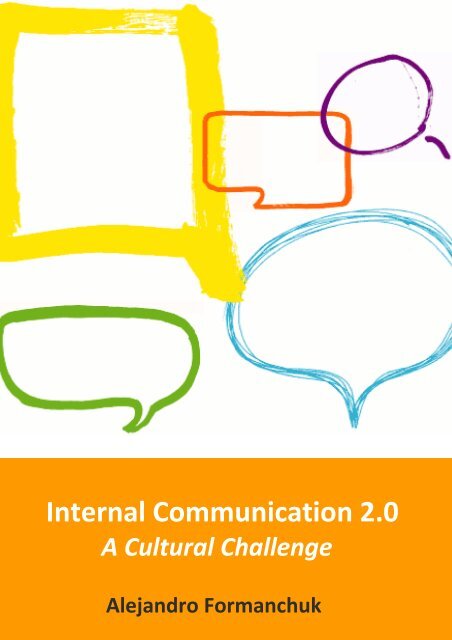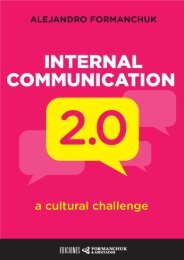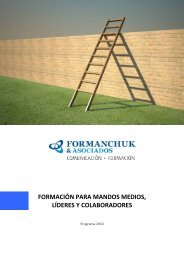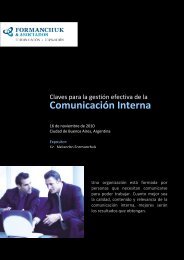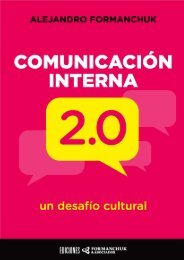Internal Communication 2.0 - Formanchuk & Asociados
Internal Communication 2.0 - Formanchuk & Asociados
Internal Communication 2.0 - Formanchuk & Asociados
You also want an ePaper? Increase the reach of your titles
YUMPU automatically turns print PDFs into web optimized ePapers that Google loves.
<strong>Internal</strong> <strong>Communication</strong> <strong>2.0</strong><br />
A Cultural Challenge<br />
Alejandro <strong>Formanchuk</strong>
<strong>Internal</strong> <strong>Communication</strong> <strong>2.0</strong>: A Cultural Challenge<br />
_______________________________________________________________________________<br />
<strong>Formanchuk</strong>, Alejandro.<br />
Original title: Comunicación interna <strong>2.0</strong>: un desafío cultural. 1ª ed. – Buenos Aires: Edición<br />
<strong>Formanchuk</strong> & <strong>Asociados</strong>, 2010.<br />
© 2010 Alejandro <strong>Formanchuk</strong><br />
The deposit provided for by Act 11723 has been made.<br />
This e-book may be reproduced and circulated by any means provided the authors are<br />
mentioned. You must not make any commercial use of this publication and you must not modify<br />
it in any form. You must give notice to the authors of how you will use the information contained<br />
in this book.<br />
Version 0.1 – November 2010<br />
All the ideas contained in this e-book are under construction. This is the version 0.1 and I really<br />
hope we can enrich this book together. Therefore, it will be a pleasure for us to receive any<br />
comments or ideas to improve this publication. Contact: alejandro@formanchuk.com.ar<br />
If you want to update this text and get more material on organizational communication,<br />
subscribe to this blog: www.formanchuk.com.ar/todosignifica and you can also visit our<br />
corporate site: www.formanchuk.com.ar<br />
Version 0.1 – Alejandro <strong>Formanchuk</strong> 2
<strong>Internal</strong> <strong>Communication</strong> <strong>2.0</strong>: A Cultural Challenge<br />
_______________________________________________________________________________<br />
1. Starting to Think and to Rethink<br />
Today many companies use <strong>2.0</strong> tools to manage both their internal and external communications.<br />
Is this a revolutionary practice?<br />
Wait a minute. Don’t answer right now.<br />
Let me tell you that many European monarchies as well as the Vatican and dozens of<br />
ultraconservative political parties around the world use Twitter, Facebook, YouTube, Wordpress<br />
and Flickr.<br />
What’s your opinion now?<br />
First conclusion:<br />
Any organization which is a little bit less formal than the British Crown should dare to be present<br />
in the social media. After all, if a queen or the Pope sign up on Twitter or create a blog, why<br />
should the director of a company be afraid to do so?<br />
Now I pose a new question which is a little bit more challenging:<br />
Why are these traditional institutions ready to use something which is supposedly so innovative?<br />
The answer is simple: because the fact of having “<strong>2.0</strong> tools” doesn’t make them “<strong>2.0</strong><br />
organizations”. To put it in a proverb:<br />
The suit does not make the man.<br />
Therefore, organizations may use social media (that is to say, they may use technology) both for<br />
internal and external communications without having to modify their culture.<br />
Is this of any good? Not so much. Cosmetic changes are only superficial.<br />
Where shall we start, then? By what is central to organizations: their culture.<br />
Version 0.1 – Alejandro <strong>Formanchuk</strong> 3
<strong>Internal</strong> <strong>Communication</strong> <strong>2.0</strong>: A Cultural Challenge<br />
_______________________________________________________________________________<br />
2. Organizational Culture <strong>2.0</strong><br />
I want to talk to you about what I know, about my work experience and about what I have found<br />
out (and I find out every day), about rights and wrongs. Companies from Latin America have been<br />
hiring us for years to strengthen their internal communication and to help them to design<br />
“internal communication <strong>2.0</strong>” strategies.<br />
But what does this mean? What do they really want when they ask for “internal communication<br />
<strong>2.0</strong>”? Basically what they want is “technological tools”: they want us to create blogs, to open<br />
Twitter accounts, to design wikis, etc.<br />
I’ll be honest with you. Those are the easiest things to sell.<br />
But those are the things I never sell (or at least I never sell them at the beginning).<br />
Because, to me, the universe <strong>2.0</strong> is the following:<br />
A cultural platform<br />
rather than a collection of technologies in “perpetual beta”<br />
A model which challenges classic ways of significance,<br />
participation and organization<br />
rather than a new harmless tool of communication<br />
One of the most important (and also irreversible?)<br />
decisions which a head of communications may take in a<br />
company<br />
rather than an insignificant decision<br />
Version 0.1 – Alejandro <strong>Formanchuk</strong> 4
<strong>Internal</strong> <strong>Communication</strong> <strong>2.0</strong>: A Cultural Challenge<br />
_______________________________________________________________________________<br />
Then, what is my approach?<br />
Culture. Culture. Culture.<br />
First, we analyze the organizational culture and its practices. Second or third, we plan the media<br />
and tools which should be used.<br />
I have a confession to make: I’m not sure if this is what companies want but I think that it is what<br />
they need. And, to be honest, I want to sleep tight every night. I like to offer projects to transform<br />
companies and to add value in the mid and long term. I like sustainable projects.<br />
<strong>Internal</strong> communication <strong>2.0</strong> calls for a culture <strong>2.0</strong>!<br />
Therefore, we should distance ourselves from the “techno-centered” viewpoint focused on the<br />
media. Or maybe:<br />
• Do companies do “internal communication” when they publish an “internal magazine”?<br />
• Do companies have more communications when their magazine has more pages?<br />
• Do companies have a better communication if the magazine is in color instead of in black and<br />
while?<br />
• Do leaders communicate better when they meet more often with their team?<br />
• Do companies update their communications when they use social media?<br />
Let’s use the culture as a “Platform to launch communications”. People express themselves<br />
according to their personality. The same happens with companies, but instead of talking about<br />
personality we use the word culture.<br />
Culture is communication in movement.<br />
I love this phrase!<br />
Version 0.1 – Alejandro <strong>Formanchuk</strong> 5
<strong>Internal</strong> <strong>Communication</strong> <strong>2.0</strong>: A Cultural Challenge<br />
_______________________________________________________________________________<br />
CULTURE: FROM 1.0 TO <strong>2.0</strong><br />
1.0 <strong>2.0</strong><br />
Employee Collaborator<br />
<strong>Internal</strong> public Multidimensional actor<br />
Human resource Person<br />
Struggle for power Change of power<br />
Centralize Decentralize<br />
Giant structure Movable units<br />
Competition Cooperation<br />
Information Dialogue<br />
Boss and sobordinates Different collaborators<br />
Linear structure Close-knit structure<br />
Director Facilitator<br />
Focus on hierarchy Focus on talent<br />
Respect gained due to position Admiration gained due to capacity<br />
People are herded People are attracted<br />
Work hard Work better<br />
Bureaucratic conglomerate Non-stop and toll-free highways<br />
Engraved on a stone Written on the sand<br />
Leader knows the most Leader is with those who know the most<br />
Hobbes Rousseau<br />
Keep Create and recreate<br />
Don’t fail Learn from mistakes and try again<br />
Administrators Entrepreneurs<br />
People adapt and repeat tasks People are nonconformists and creative<br />
Always give orders Build alliances<br />
Linear and alphabetic logic Mental maps and images<br />
Yes, Sir! And why?<br />
Obsession with reducing expenses Pasion for creating value<br />
Version 0.1 – Alejandro <strong>Formanchuk</strong> 6
<strong>Internal</strong> <strong>Communication</strong> <strong>2.0</strong>: A Cultural Challenge<br />
_______________________________________________________________________________<br />
3. Organizations Here and Now<br />
Culture <strong>2.0</strong> is not futurism. Organizations change. HERE AND NOW.<br />
I would like to tell you a story. One day I was teaching Corporate <strong>Communication</strong> at the<br />
University of Buenos Aires. I was explaining the different media of communications which may be<br />
used in a traditional company. At one point, a student raised his hand and told me that what I<br />
was explaining might not work for his company because:<br />
• He works for a “hybrid company”: two European companies merged<br />
two business units and created a third company.<br />
• The first day he got to work he had to pick up his notebook himself to<br />
start working. Literally, he approached a window, introduced himself, provided his personal<br />
information and got his computer.<br />
• He doesn’t have an office. The company occupies four floors and he can connect his computer<br />
wherever he wants. What’s more: he is encouraged to move constantly to<br />
meet new co-workers.<br />
• His boss works in Brazil and he has never seen him<br />
personally. They contact every day through MSN, Skype, e-mail or phone. But<br />
they have never shaken hands.<br />
• He takes part in many global projects simultaneously. Every project has a<br />
leader. Therefore, perhaps one month he has to report to 4 different people who are spread<br />
all over the world and he has to take part in several virtual teams.<br />
Version 0.1 – Alejandro <strong>Formanchuk</strong> 7
<strong>Internal</strong> <strong>Communication</strong> <strong>2.0</strong>: A Cultural Challenge<br />
_______________________________________________________________________________<br />
• 600 people work in the Buenos Aires office. Only 200 have been hired directly by the<br />
company. The rest are employed by human resources companies so they are<br />
outsourced.<br />
• Five people work in his area. His boss, who is in Brazil, is the only person who has been hired<br />
directly by the company. He and his co-workers come from four different human<br />
resources companies.<br />
• 30% of the staff are foreigners. Some of them stay in our country for 3 days and<br />
then leave for other countries, others stay for 3 months, some others stay a little bit longer.<br />
The people get in and out all the time. Some Argentineans also leave and lead projects in<br />
different countries for the whole year, staying in one country per month, on average.<br />
• To counteract the “Babel” effect, the company has decided that absolutely all internal<br />
communications should be written in English. The employees should write their e-<br />
mails in that language even if the recipient is Argentinean. Spanish or the local language is<br />
only allowed for informal communications.<br />
This is not a company of the year 2020. Nor is it located in California or<br />
Tokyo. It is located in Argentina in the year 2010. HERE AND<br />
NOW<br />
It provides a great opportunity to play in speculative scenarios and to practice and to exercise the<br />
brain, which, up to now, is the only organ which can perceive the future.<br />
Now let’s think what it would be like to manage the internal communications in a company of the<br />
present-future where:<br />
Version 0.1 – Alejandro <strong>Formanchuk</strong> 8
<strong>Internal</strong> <strong>Communication</strong> <strong>2.0</strong>: A Cultural Challenge<br />
_______________________________________________________________________________<br />
• The people don’t have a fixed office and never meet in the same place.<br />
• They have never seen their boss.<br />
• They report to different leaders who are in different parts of the planet.<br />
• They take part in global teams which are formed and dissolved easily.<br />
• They may lead projects and be in charge of somebody who was his “boss” up to yesterday.<br />
• They have temporary responsibilities and hierarchies.<br />
• They have as many coworkers as projects they are involved in.<br />
• They have 2 kinds of coworkers: those who they see personally and those they have never<br />
seen before.<br />
• They communicate more digitally than personally.<br />
• Meetings are something of an anachronism.<br />
• They don’t collect information because it’s impossible and unintelligent to do so.<br />
• They think that they’ll stay in the company for no more than 18 months.<br />
• They consider themselves “individual companies” which provide services.<br />
Are we talking about futurism?<br />
No. We are talking about HERE AND NOW.<br />
Can we understand this?<br />
This is the point of view of an old man who is 33 (my age at the time I am<br />
writing this book).<br />
Version 0.1 – Alejandro <strong>Formanchuk</strong> 9
<strong>Internal</strong> <strong>Communication</strong> <strong>2.0</strong>: A Cultural Challenge<br />
_______________________________________________________________________________<br />
This is me as a child.<br />
First difference: I was fair-haired.<br />
Then my hair turned brown. (My mom’s Italian genes<br />
beat my dad’s Polish genes.) But the differences don’t<br />
end there:<br />
• I was a fan of “Mazinger Z” and I could only get to see it at tea time and on only<br />
one medium: the tv.<br />
• I used to read “Anteojito”, a children’s magazine, which I used as the only source<br />
to do my homework. I used to “cut and paste” literally.<br />
• My mom also used to read “Anteojito” when she was a child.<br />
• I had to pay for all the information I got. Encyclopedias were very expensive.<br />
• My grand-mother used to borrow a neighbor’s phone to make phone calls.<br />
• In 1986 I was given a Commodore 128 computer. At that time, people were<br />
amazed by computers because of their capacity to process data.<br />
• The same year my dad bought a CD player which he used for many years. This<br />
technology lasted for at least 20 years.<br />
• I had only one category of friends: the ones I knew personally.<br />
Teaching is a pleasure but it is also a need. I get in touch with people who are much younger than<br />
I am. I think teaching would be a good exercise for many of the mature men who manage mature<br />
companies in mature economies.<br />
Version 0.1 – Alejandro <strong>Formanchuk</strong> 10
<strong>Internal</strong> <strong>Communication</strong> <strong>2.0</strong>: A Cultural Challenge<br />
_______________________________________________________________________________<br />
GOD SAVE THE GREEN!<br />
THE WORLD IS BECOMING A BETA<br />
VERSION!<br />
This means that it is ever more difficult to draw maps. We don’t know the geography and the<br />
coasts are being continuously eroded, filled, changed… The “Lost island” moves constantly. But<br />
we should not let these facts discourage us.<br />
Alvin Toffler, in his brilliant book “Future Shock”, says that “having a faint idea of what to expect<br />
is better than not having an idea at all and, in many cases, extreme accuracy is completely<br />
unnecessary”.<br />
Therefore, what is important is not to get the prediction right but to exercise the<br />
vision.<br />
In particular when you notice that the technological imagination does not work with the<br />
technology as an object but as a main myth which contains it, that is: if we stopped believing in<br />
“<strong>Communication</strong>s” as a value, the Internet would no longer be a communication technology.<br />
Let’s take a look at what “<strong>Internal</strong> <strong>Communication</strong> <strong>2.0</strong>” is and may be.<br />
Version 0.1 – Alejandro <strong>Formanchuk</strong> 11
<strong>Internal</strong> <strong>Communication</strong> <strong>2.0</strong>: A Cultural Challenge<br />
_______________________________________________________________________________<br />
4. <strong>Internal</strong> <strong>Communication</strong> <strong>2.0</strong><br />
Culture is communication in movement. I think that communication <strong>2.0</strong> moves following several<br />
of the following paths:<br />
1. Access and availability:<br />
<strong>Internal</strong> communication <strong>2.0</strong> implies that companies provide their staff with a broad<br />
access to information. (I’m tempted to say: EQUAL ACCESS!) Such access makes<br />
a lot of data available. In the past such data was forbidden or reserved to an<br />
exclusive group.<br />
Is this a test of faith? Of course it is! As it implies relying on the people to make<br />
responsible use of such information.<br />
Does it pose many risks? Yes, a lot!<br />
But let’s be honest: although many companies are willing to keep some<br />
information for themselves (their profit-and-loss statement, for example),<br />
nowadays it’s very easy to find whatever you want if you “google” it properly.<br />
The “Maginot line” is as useless as ever.<br />
2. Equality:<br />
Equality. Big word. But what does it mean in terms of communication <strong>2.0</strong>?<br />
Reducing the symmetry between those who can create contents and those who<br />
are only authorized to read and accept contents.<br />
To a certain extent, it reminds me of the “prosumer” concept, which internally<br />
means that the roles of information producers and information consumers are<br />
interchangeable in an organization.<br />
Version 0.1 – Alejandro <strong>Formanchuk</strong> 12
<strong>Internal</strong> <strong>Communication</strong> <strong>2.0</strong>: A Cultural Challenge<br />
_______________________________________________________________________________<br />
3. Usability<br />
Improving “usability” is a priority to reduce the limitations arising from the lack of<br />
technical competences. Strong will is not enough. Companies have to provide the<br />
necessary resources for “the reality not to forbid what is permitted by<br />
law”.<br />
4. Involvement:<br />
The people have to pave their own way within the communication monoblock.<br />
They should be encouraged to create, enrich, release, discuss and<br />
reformulate contents.<br />
This calls for the organization to be sensitive to different experiences and<br />
individual representations and to avoid being tempted to reduce them or group<br />
them under only one model of things able to be said o thought.<br />
Then, in practice, you’ll see if the people want or deem it necessary to take<br />
advantage of these spaces to create contents or if they prefer to engage in lurking<br />
and consume information without commenting anything or taking part in the<br />
debate.<br />
Lurking is real. And it may be a symptom of many things, such as the following:<br />
• The people are afraid to give their opinions<br />
• They do not trust in the real reasons behind the change<br />
• They are not interested because they consider the change useless or false<br />
Involvement and trust are two sides of the same coin. Involvement is a learning<br />
process, a test of value. You don’t get involved overnight. And even less when the<br />
previous logic was one of punishment, arrogance, unidirection or order.<br />
Version 0.1 – Alejandro <strong>Formanchuk</strong> 13
<strong>Internal</strong> <strong>Communication</strong> <strong>2.0</strong>: A Cultural Challenge<br />
_______________________________________________________________________________<br />
5. Interaction:<br />
<strong>2.0</strong> involves an interactive communication where the staff has the chance to<br />
create, share and take part in contents under a network paradigm and not simply<br />
under an ascending-descending bidirectional paradigm.<br />
That is the reason why an internal communication <strong>2.0</strong> scheme requires a design<br />
which is not focused on strengthening or multiplying the capacity to spread<br />
contents but on maximizing the interaction.<br />
There is a change from broadcasting or a platform to spread contents to the<br />
creation of a public square which encourages decentralized, multidimensional,<br />
multi-hierarchical and free dialogue.<br />
6. Collective Construction and<br />
Collaboration:<br />
We need to accept that good ideas come from anywhere. Yes, especially from the<br />
“bottom” of the pyramid.<br />
<strong>Internal</strong> communication <strong>2.0</strong> adheres to the cooperation in the open<br />
preparation of contents under a “Wiki” model for instance. And this requires<br />
many things. First and foremost, leaders need to validate the fact that certain<br />
contents may be produced by people who are not at the top or in the centre of<br />
the pyramid and that “meritocracy” outweighs formal hierarchy at the time of<br />
validating participations.<br />
The challenge is to organize diversity, to articulate the differences and to get<br />
micro-actions or ideas together before they are dissolved.<br />
The benefit: to strengthen collective intelligence and to change from implied<br />
knowledge to expressed knowledge.<br />
Version 0.1 – Alejandro <strong>Formanchuk</strong> 14
<strong>Internal</strong> <strong>Communication</strong> <strong>2.0</strong>: A Cultural Challenge<br />
_______________________________________________________________________________<br />
7. Listening, replying and taking action:<br />
In a <strong>2.0</strong> model, expression is the main value. When companies adhere to this<br />
culture, they minimize the logic “broadcasting” and get ready to listen to the staff<br />
because they are really willing to know what they think. They also take on the<br />
responsibility to reply to whatever is said and, most importantly, to do<br />
something about what they listen to.<br />
A typical counter example: a company creates an internal blog because they are<br />
eager to know what the people think. Everything is fine until criticism arises.<br />
What happens in 90% of the cases?<br />
• They don’t reply<br />
• Those messages are erased<br />
• There’s a witch hunt to find out who wrote those messages<br />
8. Respect and ego reduction:<br />
Good <strong>Communication</strong> is only possible when people respect and value each other.<br />
Ans this is the mantra of communication <strong>2.0</strong>, either internal or external.<br />
Here’s an example:<br />
In a company we suggested that the “Customer Care Manual” should be prepared<br />
by the employees under a Wiki model where everybody could give their ideas and<br />
where the best ideas would be chosen regardless of the author’s formal hierarchy.<br />
We faced a really big challenge (see point 6): get the leaders to accept and believe<br />
that the people who dealt with customers were smart, knew a lot, knew even<br />
more than them (that turned out to be heretic on my part and I was almost<br />
hanged!) and therefore, they were encouraged to do the following:<br />
Version 0.1 – Alejandro <strong>Formanchuk</strong> 15
<strong>Internal</strong> <strong>Communication</strong> <strong>2.0</strong>: A Cultural Challenge<br />
_______________________________________________________________________________<br />
• To think together<br />
• To write together<br />
• To decide together<br />
After all, who deals with the customers every day? THEM!<br />
I was inspired by Dan Gillmor, (journalist and author of the classic "We, the<br />
Media") when he said:<br />
“My readers know more than I do, and that’s a good thing”.<br />
Leaders should recite this mantra:<br />
“My employees know more than I do, and that’s a good<br />
thing!”<br />
This is how the story ended: the “Customer Care Manual” turned out to be<br />
excellent, with millions of productive ideas, many more than if it had been written<br />
by a boss or a know-it-all consultant. A blow to the ego? Yes, all the 1.0 leaders’<br />
egos were bruised”. But the CEO, who I know well, told me later: “Ale, so far I<br />
didn’t know that my company was full of so much talent at the base of the<br />
pyramid. Maybe it is time to redesign it. Thanks for showing it to me.”<br />
9. Network and interaction:<br />
A communication <strong>2.0</strong> scheme requires a participating and flat organization, where<br />
the interaction is not affected by classic hierarchies or unidirectional relationships.<br />
Where roles, tasks, borders, leaderships and interchanges are more flexible and<br />
dynamic, where the center and the surrounding areas are contingent, situational<br />
or blurred because of a network of interactions.<br />
Version 0.1 – Alejandro <strong>Formanchuk</strong> 16
<strong>Internal</strong> <strong>Communication</strong> <strong>2.0</strong>: A Cultural Challenge<br />
_______________________________________________________________________________<br />
10. Control reduction:<br />
Thanks to all these guidelines the company is ready to “lose” control over what is<br />
said, thought or decided. Opening the game to the model <strong>2.0</strong> means to stop<br />
wondering “how do I control what the staff says?” and start thinking “how do I<br />
take advantage of what the staff says?” (as Manuel Castells put it: “The only<br />
question which does not admit the Internet is how to control what the people<br />
publish”).<br />
• Key concept: Equipotentiality. Potentially everyone has equivalent capacities to<br />
publish information.<br />
• Additional idea: Permeable media.<br />
We should stop using Henry Ford’s phrase: “You can have any color you want as<br />
long it’s black”. Reedited: “You can say anything you want as long as you are<br />
respectful and constructive”.<br />
11. Disintermediation and Horizontality:<br />
The architecture to take part in the universe <strong>2.0</strong> entails a process of<br />
disintermediation in the production and spread of contents. The active role of the<br />
“communication prosumer” requires a space where opinions may be freely<br />
interchanged and debates may held for as long as necessary, always taking care of<br />
basic principles of respect. It is a “peer to peer” interconnection with a<br />
minimum intervention to ease the contact or the creation of the public square.<br />
Version 0.1 – Alejandro <strong>Formanchuk</strong> 17
<strong>Internal</strong> <strong>Communication</strong> <strong>2.0</strong>: A Cultural Challenge<br />
_______________________________________________________________________________<br />
INTERNAL COMMUNICATION: FROM 1.0 TO <strong>2.0</strong><br />
1.0 <strong>2.0</strong><br />
Information Dialogue<br />
<strong>Communication</strong> as a product <strong>Communication</strong> as a process<br />
Sender and receiver <strong>Communication</strong> prosumers<br />
Unidirectional communication Peer-to-peer comunication<br />
Descending and ascending paradign Networks<br />
Many affirmations Many consultations<br />
Blah, blah, bla h Listening to people a lot<br />
Data Significance<br />
The power of the megaphone The power of the neurons<br />
Vertical messages Horizontal chats<br />
Information monoblock Live communication networks<br />
A lot of passwords A lot of access<br />
Classified information Public and open information<br />
Maginot Line Google<br />
Reserving information Sharing dialogues<br />
Power of information Power of conversation<br />
Media focused on information spread Media seeking interaction<br />
“Bottle neck” Architecture of participation<br />
Broadcasting logic Decentralized interactions<br />
Information panopticon Public square for communications<br />
Egyptian pyramids Global networks<br />
Hatred of critism Celebration of dissent<br />
Fear of what is heard on the grapevine Celebration of conversation<br />
Big media Great people<br />
Version 0.1 – Alejandro <strong>Formanchuk</strong> 18
<strong>Internal</strong> <strong>Communication</strong> <strong>2.0</strong>: A Cultural Challenge<br />
_______________________________________________________________________________<br />
5. Courses of action<br />
If I had to create a tag cloud for this text, the words which would stand out would probably be:<br />
active role – collective construction – sincere listening -<br />
decentralization – open mind and access – architecture of participation<br />
- willingness to talk – fluent interaction – public square - symmetry -<br />
collective intelligence – actors and authors – neuronal layout -<br />
equipotentiality<br />
Now I’d like to share with you some thoughts that cross my mind:<br />
1. It’s not that easy to do internal communication <strong>2.0</strong><br />
Implementing an internal communication <strong>2.0</strong> scheme is a big challenge because it implies<br />
reconfiguring the company culture, practices, powers, dynamics and ways of organization.<br />
Therefore, it’s “dangerous” to do it because it will cause stress and there will be dissidents,<br />
“insiled” (people who feel exiled within the same company), but also adepts.<br />
It’s not easy. Unless we just want to create blogs and wikis and open Twitter accounts.<br />
As Michel Houellebecq put it in his book “Platform”: “Things should be clear: life, as it is, is not<br />
bad. Some of our dreams have come true. We can fly, we can breathe underwater, we have<br />
invented electric appliances and computers. The problem begins with the human body”.<br />
Version 0.1 – Alejandro <strong>Formanchuk</strong> 19
<strong>Internal</strong> <strong>Communication</strong> <strong>2.0</strong>: A Cultural Challenge<br />
_______________________________________________________________________________<br />
2. <strong>2.0</strong> is not a univocal or universal destination<br />
Not all the organizations are ready to implement communications <strong>2.0</strong> or must do it. I believe that<br />
you, as a communicator, must solve problems and not add problems. And sometimes if you force<br />
some companies to adopt the paradigm <strong>2.0</strong>, you will give them a box full of unnecessary<br />
difficulties.<br />
3. It’s very hard to create communication <strong>2.0</strong> if the culture is 1.0<br />
Culture is the key. Culture and communication go hand in hand together. If the culture is 1.0,<br />
communicating using a <strong>2.0</strong> model will be false, unproductive or even worse: counterproductive.<br />
What are our culture numbers? Sometimes they are even negative!<br />
4. Companies may be <strong>2.0</strong> without having digital tools <strong>2.0</strong><br />
My favourite conclusion. My most practiced and best implemented idea in companies. Let’s start<br />
by being <strong>2.0</strong> without technology!<br />
Let’s see: Rather that a tool, <strong>2.0</strong> is a culture or an attitude. Therefore, a company can embrace<br />
this paradigm without having to design or create “social media”. For example, I recommend that<br />
companies should reconfigure the classic work meetings under a model <strong>2.0</strong>.<br />
A meeting can be <strong>2.0</strong> because <strong>2.0</strong> implies participation. And the meeting goals are met: to ease<br />
communication, to achieve interaction among participants, to share information instantly, to<br />
create knowledge in a collaborative way, etc. In addition, a meeting has two advantages:<br />
synchronic communication and reduction of “lurking”.<br />
Technologies like Wiki for example can strengthen this attitude and act like an “anabolic steroid”<br />
in an open communication. But a simple meeting can also be <strong>2.0</strong>. And free!<br />
Version 0.1 – Alejandro <strong>Formanchuk</strong> 20
<strong>Internal</strong> <strong>Communication</strong> <strong>2.0</strong>: A Cultural Challenge<br />
_______________________________________________________________________________<br />
5. Introducing tools <strong>2.0</strong> may affect the culture<br />
I am always asked what will happen if tools <strong>2.0</strong> are introduced in a “broadcasting culture”. Is it of<br />
any good? I think that it’s better to act first on the culture itself. But in case that’s not possible,<br />
we should keep in mind that structures are both structuring and structured. Structured by the<br />
same practice they structure. That sounds paradoxical, doesn’t it?<br />
Introducing tools <strong>2.0</strong> may then have an impact on the culture because in their NDA they carry a<br />
way of <strong>Communication</strong>s, an implied logic, an energy field. They look harmless or neutral but<br />
they aren’t.<br />
It is like when you want to start working out. First, you “buy the tool”, which is the easiest thing<br />
to do. For example you buy a pair of shoes. Then alter a few days you take a look at your shoes<br />
which are in your bedroom, you take a look again, you think about the 200 dollars you spent and<br />
finally you decide to wear them. The tool encourages you to take action and, if everything turns<br />
out to be fine, your working-out routine may even be long-lasting and sustainable.<br />
Sometimes tools <strong>2.0</strong> may be like these shoes. And they may help you to tell the leader: “If we<br />
already have the blog, the wikis, etc. why don’t we really take advantage?<br />
6. Deciding what kind of social media you need to implement<br />
Let’s suppose we have the culture. We have the practices. Do we want tools? Let’s think which<br />
ones we need because they aren’t the same. For example we can focus on the following:<br />
• Expression: If we want to strengthen and ease the creation of contents on the part of the<br />
staff. We use: Blogs, Twitter, etc.<br />
• Interaction: If we are interested in easing or strengthening the communication among the<br />
company staff, creating communities or forums. We use: Facebook, Linkedin, Friendster,<br />
MySpace, Orkut, Skyrock, Netlog, Hi5, Tuenti, etc.<br />
• Collaboration and education: If we seek to create collaboration and learning, we should<br />
open a space where the staff can cooperate to create contents and ask for help or give<br />
help. We use: Wikis or social bookmarkers such as Delicias o StumbleUpon.<br />
Version 0.1 – Alejandro <strong>Formanchuk</strong> 21
<strong>Internal</strong> <strong>Communication</strong> <strong>2.0</strong>: A Cultural Challenge<br />
_______________________________________________________________________________<br />
Other angles I think about are:<br />
• What is the capacity of social media to mediatize contents? What model of<br />
communication, architecture or communication layout do they recommend?<br />
• In what ways do these social media allow or don’t allow the articulation of relationships<br />
between senders-receivers-prosumers? What is the logic?<br />
That is, the mediatization of contents and relationships.<br />
7. There isn’t an IC <strong>2.0</strong> scheme and a regular IC scheme. There is an IC<br />
scheme. Period!<br />
There isn’t a “virtual” world. All is real. And all is mediatized for a reason. This book you’re<br />
reading now is real even though you may be reading it through a “virtual” medium. If I insult you<br />
in the next sentence, you will ask me why and I won’t be able to tell you: “Ah, no, that happened<br />
in the virtual world, don’t get mad at me”. If a company’s image is torn apart on a YouTube video,<br />
their shares will fall in the “real” world and not in the market of “virtual values”. That is, we and<br />
our communications are always “real” and always have consequences. Therefore, there isn’t a<br />
communication scheme <strong>2.0</strong> and a regular or real communication scheme. There’s<br />
communication. Period!<br />
Version 0.1 – Alejandro <strong>Formanchuk</strong> 22
<strong>Internal</strong> <strong>Communication</strong> <strong>2.0</strong>: A Cultural Challenge<br />
_______________________________________________________________________________<br />
8. We’re always talking about the same thing<br />
<strong>Internal</strong> communication <strong>2.0</strong> is important because old matters are reanalyzed. Matters which I<br />
consider really important when working on internal communication:<br />
• Models of organization<br />
• Power structures<br />
• Architecture to spread information<br />
• Interaction policies<br />
• Organizational culture<br />
• Ego<br />
We’re talking about the same thing.<br />
We aren’t talking about technologies, we’re talking about models.<br />
About the same models we’ve always talked about.<br />
Version 0.1 – Alejandro <strong>Formanchuk</strong> 23
<strong>Internal</strong> <strong>Communication</strong> <strong>2.0</strong>: A Cultural Challenge<br />
_______________________________________________________________________________<br />
9. A bad message is always bad even if it’s published in media <strong>2.0</strong><br />
Mi first e-mail account was mariscal@fsoc.uba.ar and I opened it in 1996. A few months later I<br />
hired the internet service at home (while I surfed on the net I couldn’t use my phone) and that<br />
year I also created my first personal page at “Geocities”, in the category “SouthBeach”. (All this<br />
may seem prehistoric for many people who’re reading this book).<br />
I was really happy with the Internet, I thought it was too good to be true. One day I invited my<br />
grandpa home and I proudly started to show him this new wonder. He looked at me, made a<br />
poker face and told me: “Yes, it’s very nice. But a fool with the Internet is still a fool.”<br />
I didn’t dare to ask him if he was talking about me.<br />
“What internal communication media should I use for my company? What do you think about<br />
starting an internal video channel? Should our CEO have a blog?”<br />
I’m often asked this kind of questions. In companies, at seminars, in my blog. And I use my<br />
grandpa’s anecdote to explain that a bad message is still a bad message even when you give it<br />
through the most innovative, attractive or cool media.<br />
Media should not be chosen. We should separate the media from the strategy.<br />
The use of media <strong>2.0</strong> shouldn’t be a choice.<br />
The use of media <strong>2.0</strong> should be a need arising from the organizational culture<br />
itself and from the strategy.<br />
Version 0.1 – Alejandro <strong>Formanchuk</strong> 24
<strong>Internal</strong> <strong>Communication</strong> <strong>2.0</strong>: A Cultural Challenge<br />
_______________________________________________________________________________<br />
10. Technology changes, human don’t.<br />
I love this comic strip. It has a negative side which reminds me of that debate about whether the<br />
world moves forward or not opened by Ernesto Sábato in the book “On Heroes and Tombs”,<br />
when one of the characters says: “Why do you assume that the world has moved forward? Yes, I<br />
understand why. It’s better to kill human creatures with Napalm bombs than with bows and<br />
arrows”.<br />
Hard, isn’t it?<br />
But this thought has something positive: the continuance of certain behaviors, the possibility to<br />
hold on to something while the currents drag you.<br />
Technology changes all the time. All is in perpetual beta. There are so many things to learn and<br />
we have so little time. Many times I feel that whatever I do, I’ll be outdated. That someone will<br />
always come and tell me: “But how come don’t you know this tool, page, software, guru,<br />
platform, etc.?”<br />
I already accepted that this is inevitable.<br />
Version 0.1 – Alejandro <strong>Formanchuk</strong> 25
<strong>Internal</strong> <strong>Communication</strong> <strong>2.0</strong>: A Cultural Challenge<br />
_______________________________________________________________________________<br />
But it’s also true that men don’t change so much and that communicators are always addressing<br />
similar matters, common problems, shared emotions.<br />
When we work, we focus on people and not on tools. Our goals are to give long-lasting<br />
messages, to do believable actions, to have trusting conversations, to have welfare and to find<br />
professional and personal fulfillment.<br />
We are still people who communicate with people.<br />
Version 0.1 – Alejandro <strong>Formanchuk</strong> 26
<strong>Internal</strong> <strong>Communication</strong> <strong>2.0</strong>: A Cultural Challenge<br />
_______________________________________________________________________________<br />
6. Questions to keep moving forward<br />
In many of my seminars on corporate communication I ask the participants to close their eyes<br />
and imagine the future of our professional discipline. I challenge them to think and debate what<br />
they think internal communication will be like in a couple of years.<br />
To round up, I’d like to share with you some of my favorite questions to think together.<br />
Education: How will we teach communication in the future? How will a communicator be<br />
educated and who will determine such education? What will we have to know, learn, study,<br />
practice and experience?<br />
Political asset: Where will the figure of communicator be in a company? What political asset<br />
will he have? How will he manage to get such political asset? How will he interact with other<br />
areas? What will happen to the hierarchy and to the area where he will work? How will he build<br />
power?<br />
Tools and media: What will be the internal communication tools or the media of the<br />
future? What will happen to the digital universe? What will <strong>2.0</strong> turn into?<br />
Culture: How will the corporate culture be built, shared and passed on? What will the model of<br />
“good employee” and “good leader” be? How will the management climate, culture and sucess<br />
be measured? What will happen to hierarchies? How will the people be promoted? What will be<br />
the values to be communicated?<br />
Planning: What will a communication plan be like? What will it depend on? Will crises become<br />
constant and will they cause ever shorter plans to appear? Will we have to plan with fire<br />
extinguishers in hand? Will we have to make plans, plans B and the opposite plans?<br />
Version 0.1 – Alejandro <strong>Formanchuk</strong> 27
<strong>Internal</strong> <strong>Communication</strong> <strong>2.0</strong>: A Cultural Challenge<br />
_______________________________________________________________________________<br />
Interpersonal: What will be the role of interpersonal communications in our society and in<br />
the companies of the future? What will happen to informal communication? Will we hear things<br />
on the grapevine or will we read them on blogs? What will work meetings be like? Will there be<br />
anyone seating face to face withsomeone else? How will we form and strengthen teams? How<br />
will teams be leaded?<br />
Creation and circulation: How will the communication circulate in a company? What will<br />
happen to the ascending, descending and horizontal communication flow? Who will produce<br />
information and who will communicate such information? Will the “Wiki” be extended and will<br />
the knowledge be generated in teams and by anyone? Will the information still be equivalent to<br />
power or will it be the most distributed asset in the world”?<br />
This is the ending I like: with questions.<br />
Let’s go on thinking. Thanks for joining me up to here.<br />
Version 0.1 – Alejandro <strong>Formanchuk</strong> 28
<strong>Internal</strong> <strong>Communication</strong> <strong>2.0</strong>: A Cultural Challenge<br />
_______________________________________________________________________________<br />
Support:<br />
Alejandro <strong>Formanchuk</strong>. He was born in Buenos Aires in 1977.<br />
He is a Bachelor in Social <strong>Communication</strong> with an Honors Diploma granted by the<br />
University of Buenos Aires (UBA). He specializes in organizational communication.<br />
He is the President of the Argentinean Association of <strong>Internal</strong> <strong>Communication</strong>. He is<br />
the CEO of <strong>Formanchuk</strong> & <strong>Asociados</strong>, a ccmmunication consulting company. He<br />
leaded projects for more than 250 organizations in Latin America. He teaches at the<br />
UBA and taught in more than 20 universities in the region. He is an international<br />
speaker and has given conferences in Argentina, Bolivia, Chile, Colombia, Ecuador,<br />
Peru and Uruguay. Producer and Host of “Conversaciones TV”, the first on-line show<br />
on corporate communication. He has been a playwright since he was 20 years old. He<br />
loves photography and traveling.<br />
• Web: www.formanchuk.com.ar<br />
• Blog: www.formanchuk.com.ar/todosignifica<br />
• E-mail: alejandro@formanchuk.com.ar<br />
• Twitter: @formanchuk<br />
Version 0.1 – Alejandro <strong>Formanchuk</strong> 29


